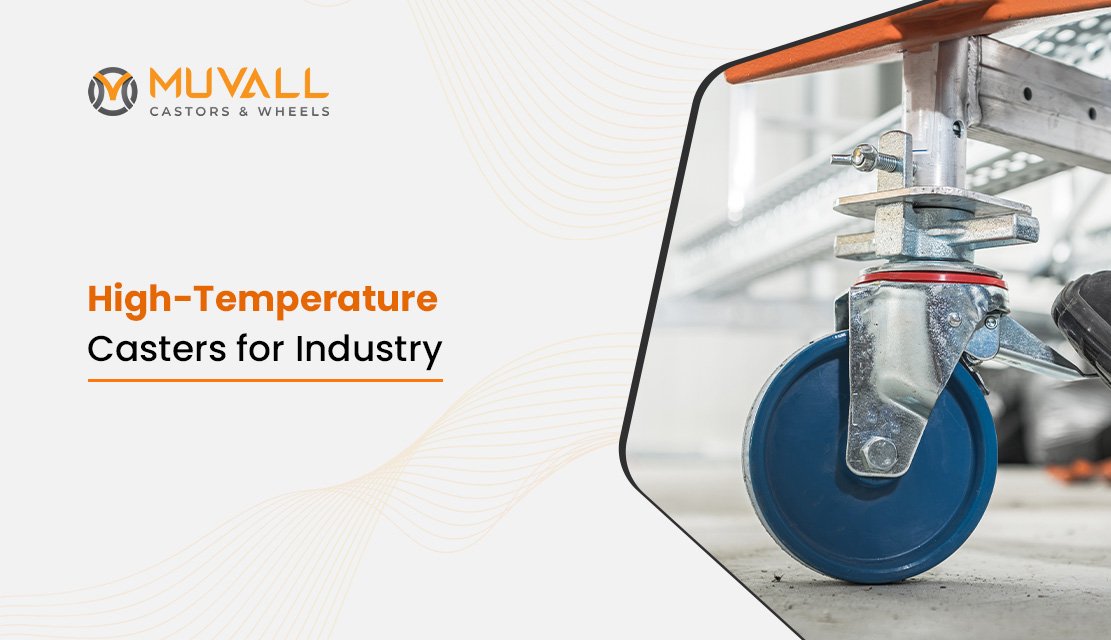
From rough ground and floors covered with debris to freezers and ovens, casters are used in many different environments. But the question is, can your casters handle the heat in your factory, or are they struggling to keep up? Not all casters are built the same.
Choosing the wrong caster for a specific task can significantly reduce its performance and, in some cases, even lead to injury. Therefore, choosing high-quality and heat-resistant casters is the smart decision for your business.
Extreme temperatures can affect various parts of a caster. It can cause the casters to wrap or deform and break down early. While most casters work well under temperatures up to 150°F, if your application involves higher heat, you will need durable and high-heat casters to get the job done.
Continue reading the blog to learn how extreme temperatures and environments affect caster wheels and why you need high-temperature casters!
The material used in caster wheels, especially polymers like polyurethane and rubber, can be greatly affected by extreme temperatures. At room temperature, these materials stay firm and hold their shape. However, when exposed to high heat, they start to soften and lose their rigidity.
This causes the wheel to flatten, a condition known as “compression set,” which creates flat spots on the wheel. As a result, the wheel becomes harder to roll. This increases the force needed to push or pull the equipment, which, in turn, increases the risk of injury.
Bearings can also be impacted by high temperatures, especially if they are not sealed. When exposed to heat, the grease inside the bearing can lose its thickness and start to leak out. Without enough grease, the bearing does not get proper lubrication. This makes it harder to move the cart. This same issue can happen in the swivel part of a caster if not sealed properly.
When selecting a caster for high-temperature use, it is crucial to check the recommended temperature limits for the wheel material. Make sure to choose a caster with a sealed swivel head and precision-sealed bearings to ensure better performance and durability.
In high-temperature industrial settings, specialized equipment like heat-resistant oven casters and high-temperature urethane wheels is essential. Understanding how temperature affects caster performance and lifespan is crucial. Standard industrial caster wheels typically cannot handle environments above 150°F.
It is where heat-resistant or high-temperature casters are needed. High-temperature casters are specially designed wheels built to handle extreme heat. They are made from materials like cast iron, Phenolic and high-temperature glass filled Nylon. As a result, they won’t break down or lose their strength in high temperatures.
These casters are commonly used in industries like food processing, manufacturing and automotive, where equipment is frequently exposed to heat or are a part of a trolley that takes the material inside an oven for heat treatment.
Using casters built for high temperatures helps reduce the risk of equipment failure from heat exposure. This lowers the chances of accidents and injuries.
These casters come in various sizes and weight capacities. This makes them ideal for a variety of uses in different industries.
Choosing high-quality and durable casters lowers the need for frequent replacements and maintenance. This leads to long-term cost savings.
High-temperature casters ensure smooth and efficient movement of equipment and materials. This supports continuous workflow and productivity in hot environments.
In manufacturing plants, especially those with metalworking, kilns and furnaces, high-temperature casters are essential. They allow safe and efficient movement of materials and equipment, even in areas close to heat sources.
In automotive manufacturing and repair shops, high-temperature casters are used on equipment like welding machines and ovens, where heat is always present.
Bakeries, commercial kitchens and food processing plants often work in high-heat environments. Casters designed to handle these conditions are essential for moving hot racks, trays and equipment.
In some medical and laboratory settings, equipment needs to be sterilized at high temperatures. High-temperature casters make sure that autoclaves and other heat-sensitive stay mobile and work properly.
Selecting the right high-temperature castors is crucial for ensuring durability, performance, and safety in extreme heat conditions. To make the best choice, consider these key factors:
Ensure that the castors can withstand the maximum temperatures they will be exposed to. Muvall Castors offers three high-temperature options:
To prolong the lifespan of these castors, limit continuous exposure to high temperatures to a maximum of two hours at a time and adjust load capacities accordingly.
Choose castors that can support the weight of the equipment and materials being transported. Higher temperatures can affect material integrity, so selecting castors with a safety margin in weight capacity is essential.
The environment plays a key role in material selection. If your workspace involves exposure to chemicals, oils, or moisture, ensure that the chosen castor material is resistant to these elements to prevent degradation.
Larger wheels improve maneuverability and help distribute the load more effectively, reducing stress on the flooring and increasing the lifespan of the castors.
By considering these factors, you can select the right high-temperature castors to ensure smooth operations, enhanced safety, and longer service life in demanding heat-intensive environments.
Also Read: Ultimate Guide to Choosing the Right Outdoor Caster Wheels Material
It is essential to select casters that are built to handle high temperatures or wet conditions, while still providing easy movement. These casters are made from special materials that can handle extreme heat without failing too soon.
This is how they perform well and last longer. Whether in manufacturing, automotive, healthcare or food processing, choosing the right high-temperature casters can boost productivity and safety.
Contact Muvall today for expert advice on the best options for your specific temperature needs. We can help you find the right casters to ensure top performance in your environment.